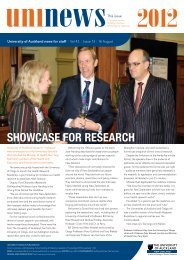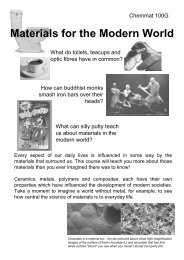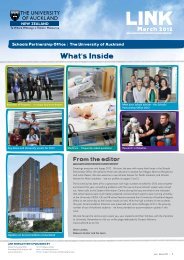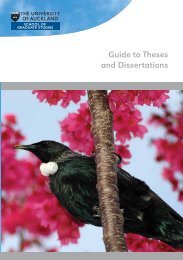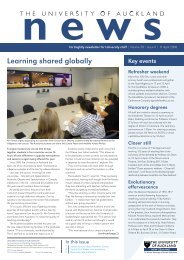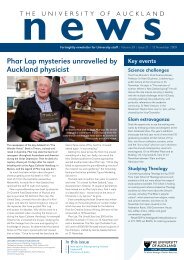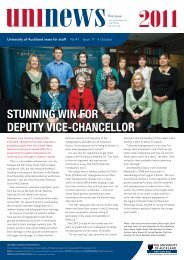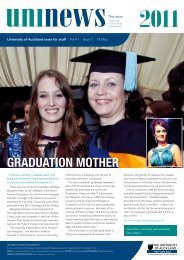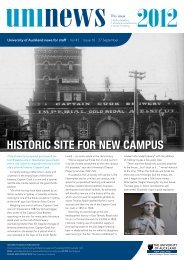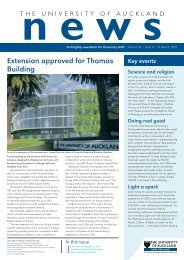Architects' winning design - The University of Auckland
Architects' winning design - The University of Auckland
Architects' winning design - The University of Auckland
You also want an ePaper? Increase the reach of your titles
YUMPU automatically turns print PDFs into web optimized ePapers that Google loves.
insight: Maramatanga<br />
telling it liKe it is<br />
Annie goldson “tells personal stories to tell<br />
bigger stories”.<br />
This is an understatement. <strong>The</strong> stories Annie<br />
tells are huge, gritty, global. <strong>The</strong>y expose the<br />
very depths <strong>of</strong> humanity.<br />
Her latest documentary Brother Number One<br />
follows the story <strong>of</strong> happy carefree Kiwi yachtie<br />
Kerry Hamill, who in 1979 while living an idyllic<br />
dream sailing <strong>of</strong>f the Gulf <strong>of</strong> Thailand strayed<br />
into Cambodian waters. He sailed into the arms<br />
<strong>of</strong> the Khmer Rouge; sailed into Hell.<br />
Kerry was the eldest son (brother number one)<br />
<strong>of</strong> the Hamill family from Whakatane Heads.<br />
“Brother Number One is his story,” she says, “but<br />
it is also the story <strong>of</strong> two million others.”<br />
“In the 1970s, in the wake <strong>of</strong> the Vietnam War<br />
and deeply entrenched in Cold War politics, the<br />
nations <strong>of</strong> the world turned their eyes away from<br />
Cambodia. <strong>The</strong>y knew what would happen.”<br />
Over the next four years under the power <strong>of</strong><br />
fanatical Khmer Rouge leader Pol Pot, who had<br />
assumed the self-appointed title <strong>of</strong> “Brother<br />
Number One”, the country began “restarting<br />
civilisation”. While the world stood back Pol Pot’s<br />
ill-fated utopia resulted in the genocide <strong>of</strong> two<br />
million people through slavery, starvation,<br />
torture and execution.<br />
“Apart from the film <strong>The</strong> Killing Fields people<br />
are ignorant <strong>of</strong> this atrocity, ignorant <strong>of</strong> history<br />
8 29 July 2011<br />
which saw the greatest war criminals since the<br />
Third Reich aided and abetted by China, the US<br />
and the Western powers. Younger people don’t<br />
even know who Pol Pot is.”<br />
Brother Number One interweaves the<br />
enormity <strong>of</strong> that atrocity with the personal<br />
emotional journey <strong>of</strong> Kerry’s younger brother,<br />
Rob Hamill, New Zealand Olympic and<br />
trans-Atlantic champion rower.<br />
When the tragedy <strong>of</strong> Kerry’s death was<br />
uncovered 16 months after he went missing it<br />
was greeted with a repressive stoicism typical <strong>of</strong><br />
Pakeha provincial New Zealand. Rob’s is a<br />
journey to honour his brother’s memory by<br />
finding and telling his story, to discover the truth<br />
surrounding the capture, incarceration and<br />
murder; perhaps also to forgive and find peace.<br />
“I see in Rob an almost Shakespearean<br />
dilemma, caught between a desire to forgive but<br />
being consumed with a righteous hatred: how he<br />
has to struggle with that on a daily basis and<br />
how it impacted just one family. When you<br />
extrapolate that to two million people dead you<br />
try to imagine what happens to a whole culture,”<br />
says Annie.<br />
As I sit in Annie’s dimly-lit <strong>of</strong>fice and speak<br />
with this world-acclaimed director, still wearing<br />
her large impenetrable sunglasses, she explains<br />
the film is “observational”, “capturing reality as<br />
it happens”. It documents the closed world Kerry<br />
found himself in through a richness <strong>of</strong> bleak<br />
archival footage and eye-witness testimonies<br />
pieced together in a forensic exactness.<br />
“<strong>The</strong> film raises issues about accountability,<br />
culpability and justice; about regional issues. It<br />
raises questions about artifice and legitimacy,<br />
about what it means to forgive. It actually<br />
questions the complicity <strong>of</strong> the whole world in<br />
what happened in Cambodia.<br />
“After the Vietnam War there was no way that<br />
the world was going to step in. <strong>The</strong>re are a lot <strong>of</strong><br />
reasons why Cambodians could be very cynical<br />
and why to some degree these disasters are not<br />
just national issues,” says Annie. “In its broadest<br />
sense the film is an attempt to try to stop<br />
genocide occurring again.”<br />
In her cool, measured story-telling and with<br />
the immediacy <strong>of</strong> raw emotion, Annie Goldson is<br />
set to reacquaint the world with its own history.<br />
And now, just over three decades after Pol Pot,<br />
Brother Number One will turn, fix and hold eyes<br />
and ears across the globe to scenes <strong>of</strong><br />
Cambodia. This time no one will look away.<br />
Megan Fowlie<br />
Rob Hamill



